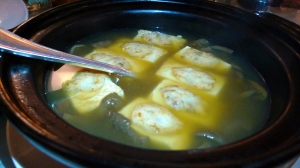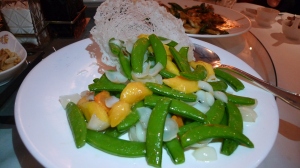The final meal we had in Hong Kong over the New Year’s holiday was the most exciting and most memorable: a visit to a hole-in-the-wall Chinese burger bar called Little Bao.

Located at the quiet end of Staunton Street in Central, a short walk from the escalator, Little Bao occupies a tiny storefront – maybe two dozen seats – with a large neon sign on the exterior. The restaurant doesn’t take reservations so we arrived about 6:30 on a weekday and faced an estimated wait of one hour. The friendly woman taking names suggested some nearby watering holes and offered to call when our table was ready, despite the fact that my phone number was overseas.

In about fifty minutes, my phone rang and she let us know we could finish up our drinks and head back to the restaurant. We scored four prime seats, nestled along the counter facing the kitchen. (A second counter is placed along the wall to the left.) This afforded us a great view of the action. Adam, a friendly fellow, was running the front of the house and despite the hectic operation, had time to walk us through the menu and answer questions.
Little Bao has a short wine list with excellent selections from the Pacific Northwest. Thanks to there being no duties on wine imports in Hong Kong, these were good values and complemented the food very well.
The menu is divided into two sections. The first features baos - steamed buns filled hamburger-style with different ingredients – that are not intended for sharing. They have a strict “no cutting” policy although we did share our baos, each taking a bite and passing them unhygienically amongst our friends. The other part of the menu are dishes designed for sharing. With four people, we ordered one of nearly everything on the menu.

The first dish to arrive was the orange chicken – fried chicken with salty egg yolk, a honey glaze, and orange zest. The salty egg yolk, a common but sometimes overpowering ingredient in Chinese cuisine, elevated the fried chicken to another level. You had a nice balance of sweet, salty, and savory with the citrus zest cutting through to unite the flavors.

These short-rib pan fried dumplings (essentially gyoza) were filled with slow-braised beef short rib that was tender and rich, and served on a bed of celeriac coleslaw. It was like a pleasant collision of a plate of barbecue beef brisket and coleslaw with a Chinese take-out container filled with potstickers.

The next dish was clams with bacon and potato, served in a white pepper miso broth with toasted miso-butter baos. The clams were tender and sweet and the broth was an interesting study in complementary flavors: the umami that comes from the miso and the subtle heat of white pepper.

As they had been recommended by many reviewers, we also ordered the LB fries, served with a side of roasted tomato sambal and kewpie mayo. There’s a spray of lime on the fries but there must be something else – cocaine, perhaps? – that makes these batons of fried potatoes so very addictive.

Directly in front of us was the bao preparation station. There are only four bao on the menu plus one special. We ordered all of them except for the regular chicken bao. Each bao was about four to five bites – about the size of a modest (but very vertical) hamburger. I can understand why they have a no-cutting policy: ingredients would fall out and you would lose out on the flavor gestalt of the experience.

If I’m not mistaken, from left to right the bao pictures are the fish tempura (with tamarind palm sugar glaze and pickled lemongrass fennel salad), the pork belly (slow braised with lek and shiso red onion salad, sesame dressing, and hoisin ketchup), the Sloppy Chan (Taiwanese braised shitake tempeh, truffle mayo, sweet pickled daikon, and fried shallot), the pork belly again, and the special of the day, a spicy fried chicken bao.

In the interest of giving you a closer look, here is the special, the spicy fried chicken with garlic black bean mayo and scallion coleslaw. All of the baos were tasty and they all succeed for the same reason: there aren’t too many ingredients, but enough to make the dish interesting. There are different textures and flavors and the soft but toasted bao bun absorbs some of the sauce so it isn’t just a neutral carrier for the ingredients but very much a part of the dish.
The food, which is excellent, is only a part of what makes Little Bao such a pleasant dining experience. There is a really good energy to the place. Part of this is because it is small and crowded, but in a way that feels intimate instead of cramped. Part of it is because there is great music, but at a volume low enough that you can still hear conversations with fellow diners. But the biggest part of the good energy is that you can tell that the staff seems to really love what they are doing and they enjoy working with each other.

From what I’ve read, credit for that goes to the chef May Chow (pictured above). With a Canadian and Hong Kong background by way of the United States, she has built a team that is chosen for attitude rather than experience, treated well, and motivated based on their own interests. (Read more about that here.) I had a chance to chat with her for a few minutes and was very impressed with the way she thinks about food and running a restaurant. Thanks to a quick response to one of my Instagram photos, I also discovered that we have a common chef friend here in Bangkok: Jess Barnes of Opposite Mess Hall. In-depth profile of May at SassyHongKong.com here.

Just as we were reaching that point of satiation, dessert arrived. There is only one dessert on the menu and that’s okay because that one dessert is so perfect, there is no need for anything else! It is an ice cream sandwich made with deep-fried bao, green tea ice cream, and a drizzle of sweetened condensed milk. When I write that it is “so perfect,” I mean that it achieves a spectacular balance of flavors and textures that is satisfying and made for the ideal end to this meal.
You can probably tell that I enjoyed the meal, huh?
Anyhow, if you are in Hong Kong, I would strongly recommend a visit to Little Bao. Come with one or two other people so you can share but not with a large group otherwise you will never get seated. Come prepared to wait a bit – bring a book or go to one of the nearby bars for a drink. Most importantly, come with an appetite, because you’ll need it.




























































Recent Comments